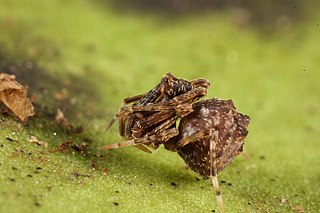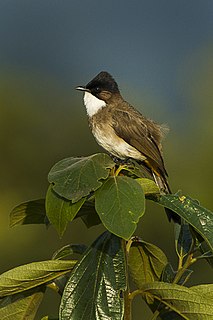
The Ixodidae are the family of hard ticks or scale ticks, one of the three families of ticks, consisting of over 700 species. They are known as 'hard ticks' because they have a scutum or hard shield, which the other big family of ticks, the 'soft ticks' (Argasidae), lack. They are ectoparasites of a wide range of host species, and some are vectors of pathogens that can cause human disease.

The spider family Liphistiidae, recognized by Tamerlan Thorell in 1869, comprises 8 genera and about 100 species of medium-sized spiders from Southeast Asia, China, and Japan. They are among the most basal living spiders, belonging to the suborder Mesothelae. In Japan, the Kimura spider is well known.

Ornithoctoninae is a subfamily of tarantulas found in Southeast Asia. It was first erected in 1895 by Reginald Innes Pocock based on the type specimen Ornithoctonus andersoni. Terrestrial members of this subfamily are often known as earth tigers.

Tetrablemmidae, sometimes called armored spiders, is a family of tropical araneomorph spiders first described by Octavius Pickard-Cambridge in 1873. It contains 126 described species in 29 genera from southeast Asia, with a few that occur in Africa and Central and South America. Pacullidae was incorporated into this family in 1981, but was later restored as a separate family in a 2016 phylogenetic study.

Archaeidae, also known as assassin spiders and pelican spiders, is a spider family with about ninety described species in five genera. It contains small spiders, ranging from 2 to 8 millimetres long, that prey exclusively on other spiders. They are unusual in that they have "necks", ranging from long and slender to short and fat. The name "pelican spider" refers to these elongated jaws and necks used to catch their prey. Living species of Archaeidae occur in South Africa, Madagascar and Australia, with the sister family Mecysmaucheniidae occurring in southern South America and New Zealand.
Ornithoctonus is a genus of Southeast Asian tarantulas that was first described by Reginald Innes Pocock in 1892. As of May 2020 it contains three species, found in Thailand and Myanmar: O. andersoni, O. aureotibialis, and O. costalis.

Raorchestes andersoni is a species of frog in the family Rhacophoridae. It is found in northeast India, northern Myanmar, and Tibet and Yunnan, China. The common names Anderson's bubble-nest frog, Anderson's bush frog and tuberculed small treefrog have been coined for it.

The brown-breasted bulbul is a songbird in the family Pycnonotidae. The species was first described by John Anderson in 1869.

The Anderson's shrew mole is a species of mammal in the family Talpidae. It is endemic to China. Its species name "andersoni" was chosen to honor American scientific collector Malcolm Playfair Anderson.

Coneweb spiders (Diguetidae) are six-eyed haplogyne spiders that live in tangled space webs, fashioning a cone-like central retreat where they hide and lay eggs. It is a small family, containing only two genera with fifteen species and is confined to the New World, preferring deserts. Members of the genus Diguetia usually build their webs in shrubs or between cactus pads. They have the same eye arrangement as the venomous recluse spiders, but none are known to be harmful to humans.

Corethrellidae are a family of biting midges, small flying insects belonging to the order Diptera, females of which feed on the blood of frogs. The members of the family are sometimes known as frog-biting midges. The family currently consists of just one genus, totalling 115 extant and 10 fossil species worldwide. Most extant species are found in the lower latitudes, usually associated around the tropics.
Chilobrachys guangxiensis is a species of tarantula native to China, in Hainan. Despite the name, the spider probably does not occur in Guangxi.

Chilobrachys is a genus of Asian tarantulas that was first described by Ferdinand Anton Franz Karsch in 1892.

Phlogiellus is a genus of tarantulas that was first described by Reginald Innes Pocock in 1897.
Chilobrachys nitelinus, is a species of spider of the genus Chilobrachys. It is endemic to Sri Lanka.
Hunyadiscus andersoni is a species of air-breathing land snail, a terrestrial pulmonate gastropod mollusk in the family Plectopylidae.

Chilobrachys dyscolus is a species of tarantulas found in Vietnam.

Chilobrachys fimbriatus, commonly known as the Indian violet, is a species of spider of the genus Chilobrachys. It is endemic to India.
Eptesicus pachyomus is a species of bat in the family Vespertilionidae. It is widespread and found throughout Asia.













